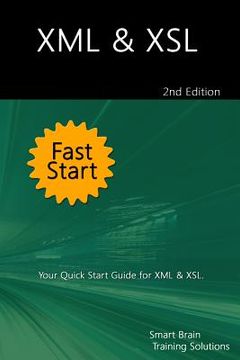Compartir
XML & XSL Fast Start 2nd Edition: Your Quick Start Guide for XML & XSL (en Inglés)
Smart Brain Training Solutions
(Autor)
·
Createspace Independent Publishing Platform
· Tapa Blanda
XML & XSL Fast Start 2nd Edition: Your Quick Start Guide for XML & XSL (en Inglés) - Training Solutions, Smart Brain
$ 429.20
$ 715.33
Ahorras: $ 286.13
Elige la lista en la que quieres agregar tu producto o crea una nueva lista
✓ Producto agregado correctamente a la lista de deseos.
Ir a Mis Listas
Origen: Estados Unidos
(Costos de importación incluídos en el precio)
Se enviará desde nuestra bodega entre el
Viernes 12 de Julio y el
Lunes 22 de Julio.
Lo recibirás en cualquier lugar de México entre 1 y 3 días hábiles luego del envío.
Reseña del libro "XML & XSL Fast Start 2nd Edition: Your Quick Start Guide for XML & XSL (en Inglés)"
Need a precise, focused training guide for XML & XSL?Get this 130-page Fast Start guide to quickly learn XML & XSL fundamentals. Regardless of whether you are an IT manager, developer, administrator or an advanced user, this Fast Start guide will help you learn the essential concepts needed to successfully work with XML & XSL.Covers all versions of XML & XSL.What is XML? XML, or eXtensible Markup Language, is a metalanguage. That is, it's a language that can be used to describe other languages and a specification for storing information. Although XML and HTML may seem to have a lot in common, in reality the difference between them is like the difference between night and day. HTML is used to format information, but it isn't very useful when it comes to describing information. For example, you can use HTML to format a table, but you can't use HTML to describe the data elements within the table. The reason for this is that you can't really depict something as abstract as a distributor or a customer with HTML, which is where XML comes into the picture. XML can be, and is, used to define the structure of data rather than its format. This Fast Start guide begins by showing you the basics of the XML language and then builds on that knowledge to show you how to create, style and transform documents.1. XML Basics72. Using XML11Extensions to XML12XLink and XPointer12XSL13XML Namespaces14XML Schema14XPath14Creating XML-Based Solutions15Authoring Tools15Application Development Environments15Database and Data Integration Solutions16XML Document Structure16XML Naming Rules173. Working with Root, Parent, and Child Elements19Understanding Root Elements19Understanding Parent and Child Elements20Nesting Parent and Child Elements20Adding Root Elements to Documents214. Defining XML Elements and Tags23Using Elements Tag Pairs23Using Empty Elements255. Using XML Attributes29Defining Attributes29When To Use Attributes31Adding Attributes to Elements326. Additional Structures in Elements35Using Predefined Entity References35Using Character Data Sections37Using Comments38Using Processing Instructions407. Specifying XML Declarations43Using the Version Attribute43Using the Encoding Attribute44Using the Standalone Attribute458. Creating Well-Formed Documents479. Understanding DTDs49Using Elements in DTDs52Using Attributes in DTDs5310. Introducing XSL5711. Matching Structures to Template Rules63Understanding the Element and Root Nodes Template65Understanding the Modes Template66Understanding the Text and Attribute Nodes Template67Understanding Other Built-In Templates6712. Structuring XSLT Stylesheets6913. Defining the Output Format73Setting Attributes for the output Element73Formatting Output as XML or XML-Based Markup75Formatting Output as HTML81Formatting Output as Text or Program Source Code87Setting the Output Format8914. Defining Template Rules and Declarations92Creating the Root Template92Creating and Applying Template Rules93Outputting the Contents of Nodes9715. XPath Operators & Expressions9916. Understanding XPath Operators and Datatypes10717. Using Relative XPath Expressions111Referencing the Current Context Node111Referencing a Parent Node112Referencing Siblings Relative to the Current Context113Referencing Child Nodes11418. Using Absolute XPath Expressions11919. Locating Other Nodes121Working with Attribute Nodes121Working with Text Nodes124Working with Comment Nodes125Working with Processing Instruction Nodes12620. Using Namespaces with Element and Attribute Nodes12921. Using Wildcards and Predicates in XPath Expressions131Selecting Any Node131Skipping Levels in the Hierarchy133Filtering To Match Nodes with Specific Values 13522. More Options...137
- 0% (0)
- 0% (0)
- 0% (0)
- 0% (0)
- 0% (0)
Todos los libros de nuestro catálogo son Originales.
El libro está escrito en Inglés.
La encuadernación de esta edición es Tapa Blanda.
✓ Producto agregado correctamente al carro, Ir a Pagar.

